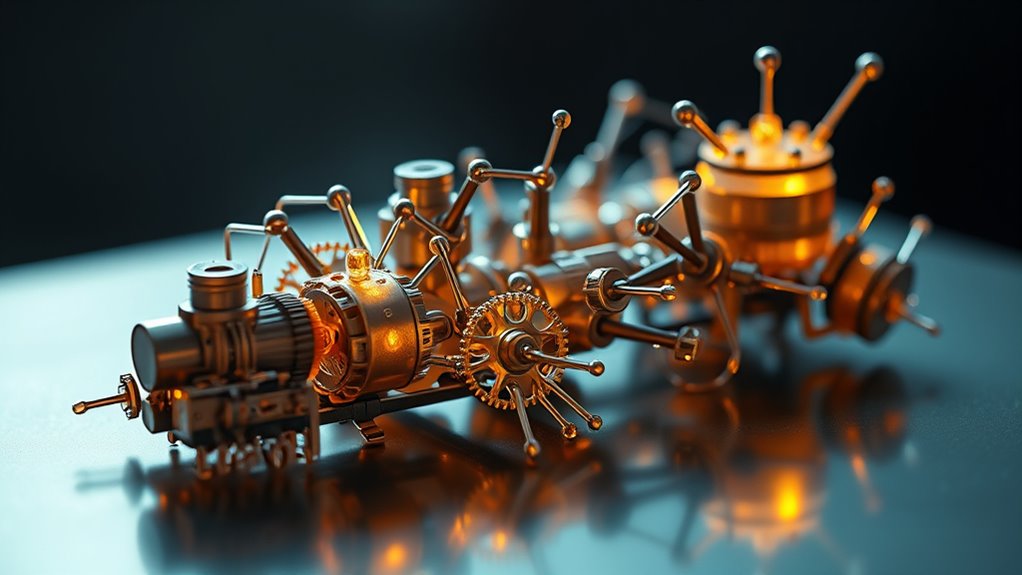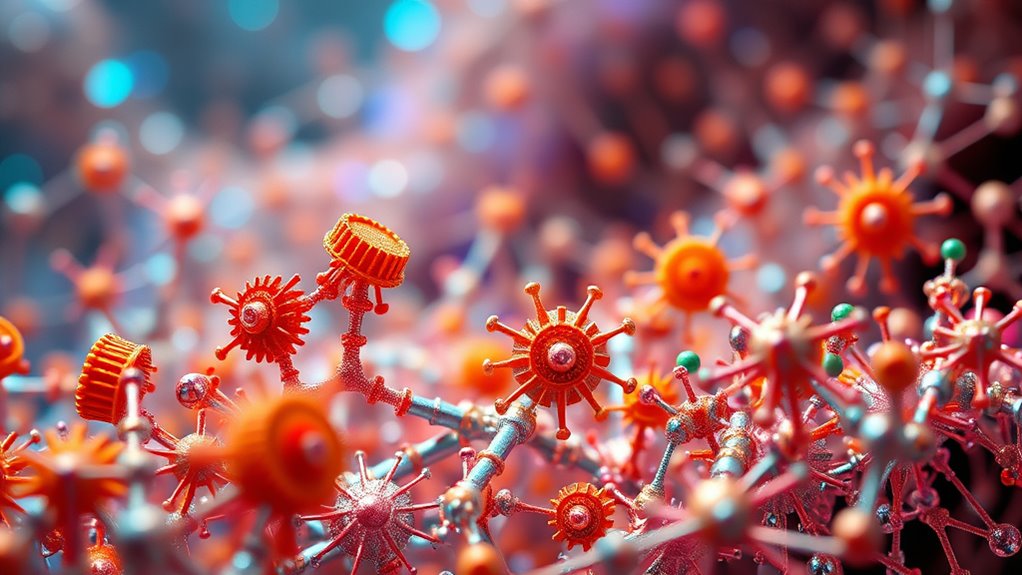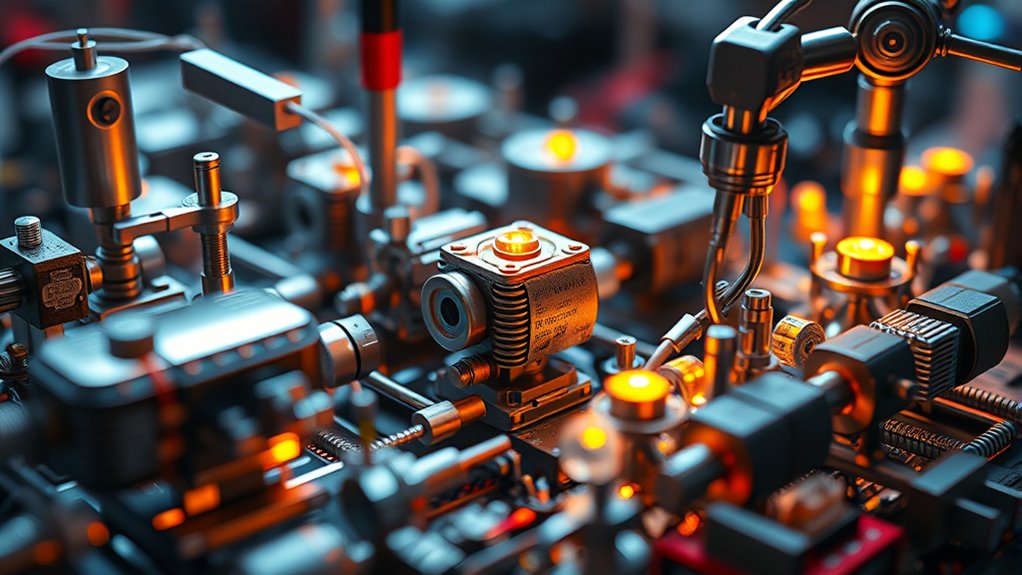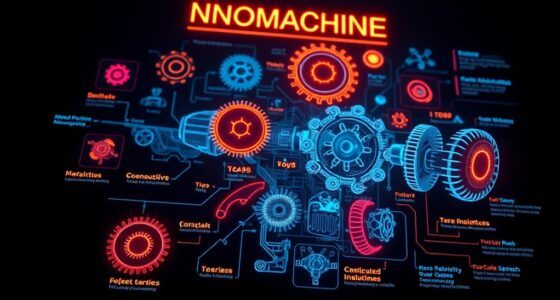Nanomachines come in four main types: motors, pumps, switches, and assemblers. You can think of motors as tiny engines converting energy into movement, helping to control motion at the nanoscale. Pumps move fluids precisely at small scales, essential for drug delivery and chemical reactions. Switches act like tiny valves, regulating signals or processes, while assemblers build complex structures with molecular accuracy. To discover how these tiny devices work together, keep exploring these fascinating nanotechnology components.
Key Takeaways
- Nanomotors convert energy into mechanical motion for precise nanoscale movement and manipulation.
- Nanoscale pumps control fluid flow and transport molecules within tiny environments.
- Molecular switches regulate signals by changing states in response to stimuli like light or pH.
- Assemblers build complex nanostructures by precisely positioning individual molecules.
- These nanomachines enable advanced applications in medicine, electronics, and materials science.
Nanomotors and Their Roles in Motion Control

Nanomotors are tiny devices that can generate movement at the nanoscale, making them essential for advanced nanotechnology applications. They convert energy into mechanical motion, allowing precise control over movement within nanostructures. You can think of them as the engines that power nanoscale machinery, enabling tasks like targeted drug delivery, molecular assembly, and sensing. These motors operate through various mechanisms, including chemical reactions, light activation, or magnetic fields. Their ability to produce controlled, directional movement is critical for manipulating individual molecules or small components. By providing the necessary force and motion, nanomotors help you build complex nanodevices with high precision. This capability opens doors to innovations in medicine, electronics, and materials science, where precise control at the molecular level is increasingly essential. The mechanisms behind their operation are vital for optimizing performance and expanding their applications in cutting-edge fields.
Nanoscale Pumps for Fluid Manipulation

Nanoscale pumps are specialized devices designed to control and move fluids at the molecular level, enabling precise manipulation within tiny environments. These pumps are essential for applications like targeted drug delivery, lab-on-a-chip systems, and nanoscale chemical reactions. They work by generating controlled forces to transport fluids through channels or membranes. Key features include:
Nanoscale pumps precisely control fluid movement for advanced biomedical and chemical applications.
- Precise flow regulation at nanoliter or picoliter scales
- Integration with other nanomachines for complex tasks
- Minimal energy consumption for efficiency
- Compatibility with biological systems for biomedical uses
Such pumps rely on mechanisms like chemical gradients, electromagnetic fields, or mechanical deformation. Their ability to manipulate fluids accurately at the nanoscale opens new avenues for research and technology, making them crucial components in advanced nanodevices and scientific experiments. Additionally, material selection plays a vital role in optimizing pump performance and durability.
Molecular Switches for Signal Regulation

Building on the ability of nanoscale pumps to control fluid flow, molecular switches serve as essential regulators within nanodevices by modulating signals at the molecular level. These switches change their state in response to specific stimuli, such as light, pH, or voltage, enabling precise control of nanodevice functions. They act like tiny on/off valves, directing information flow or activating downstream processes. To visualize, consider the following:
| Stimulus | Switch State | Function |
|---|---|---|
| Light | On | Signal transmission |
| pH change | Off | Signal interruption |
| Voltage | On | Activation of machinery |
| Chemical | Off | Deactivation |
This simplicity allows molecular switches to play a fundamental role in nanoscale signal regulation, making them crucial components in complex nanomachines. Additionally, understanding the emotional journey of decluttering can provide insights into managing complex systems by promoting clarity and efficiency.
Assemblers for Building at the Nanoscale

Assemblers at the nanoscale are sophisticated tools that construct complex structures by precisely positioning individual molecules and components. They act like tiny robotic builders, arranging atoms with accuracy unattainable by conventional methods. These assemblers enable you to create materials with customized properties, such as strength, flexibility, or conductivity. They can assemble molecules into specific configurations, forming nanodevices or functional nanomaterials. Key features include:
Nanoscale assemblers precisely build complex structures, enabling customized nanomaterials with remarkable accuracy and potential for scalable innovation.
- High precision in positioning individual atoms or molecules
- Ability to build complex 3D nanostructures
- Compatibility with various molecular components
- Potential for automation and scalability
- Cost-effective strategies can be employed to optimize the assembly process for different applications.
Frequently Asked Questions
What Materials Are Typically Used to Construct Nanomachines?
You typically use materials like carbon-based compounds, such as graphene and carbon nanotubes, because they’re strong and flexible. Gold and silver are common for their conductivity, while silicon is popular for electronic components. Sometimes, you’ll find polymers or DNA strands in nanomachines for their versatility and biocompatibility. These materials allow you to build tiny devices that can perform precise tasks at the nanoscale effectively.
How Do Nanomachines Communicate With Each Other?
Think of nanomachines as tiny musicians in an orchestra, communicating seamlessly to create harmony. They send signals through chemical messengers, like neurotransmitters, or use electrical signals similar to wires in a circuit. You’ll find they also exchange information via vibrations or light signals. This coordination allows them to work together precisely, ensuring their tasks are synchronized, much like a well-conducted symphony.
What Are the Energy Sources Powering Nanomachines?
You should know that nanomachines are powered by various energy sources like chemical reactions, such as catalytic processes, or external stimuli like light, heat, or electric fields. You might also find them using bio-inspired energy, tapping into biological molecules or energy gradients. These sources provide the power needed for nanomachines to perform their tasks efficiently, enabling precise control at microscopic scales.
How Do Nanomachines Ensure Precision at Such Small Scales?
You guarantee nanomachines achieve precision by designing them with highly specific structures and control mechanisms at the molecular level. They use targeted interactions like ligand binding or conformational changes to perform tasks accurately. Additionally, external controls such as magnetic, electric, or optical signals help guide their actions. This combination of precise design and external modulation allows nanomachines to operate with incredible accuracy despite their tiny scale.
What Are Potential Ethical Concerns Regarding Nanomachine Deployment?
You might worry that nanomachines could spiral out of control, causing unpredictable damage or privacy breaches on a massive scale. Ethical concerns include potential weaponization, environmental harm, and deepening social inequalities. You should stay vigilant about regulation and transparency, ensuring these tiny marvels serve humanity responsibly. Ignoring these issues could lead to a future where technology surpasses our control, turning our greatest innovations into our biggest risks.
Conclusion
You now see how nanomachines act like tiny architects, tirelessly building and moving at the atomic level. Picture these motors spinning effortlessly, pumps guiding fluids with precision, switches toggling signals in a dance of electrons, and assemblers crafting intricate structures. Together, they form a bustling nanoscale city, working silently yet relentlessly. This miniature world holds the key to revolutionary advancements, where your imagination sparks endless possibilities for innovation and discovery at the smallest scales.









